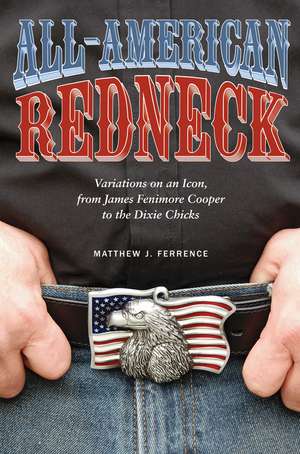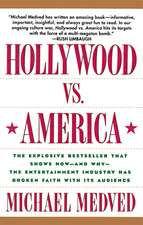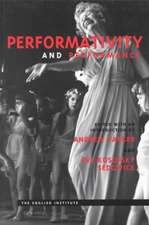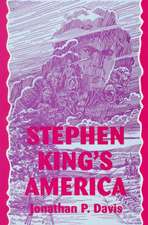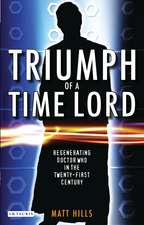All-American Redneck: Variations on an Icon, from James Fenimore Cooper to the Dixie Chicks
Autor Matthew J. Ferrenceen Limba Engleză Hardback – 30 mar 2014
In contemporary culture, the stereotypical trappings of “redneckism” have been appropriated
for everything from movies like Smokey and the Bandit to comedy acts like that of Larry the
Cable Guy. Even President George W. Bush shunned his patrician pedigree in favor
of cowboy “authenticity” to appeal to voters. Whether identified with hard work and patriotism
or with narrow-minded bigotry, the Redneck and its variants have become firmly
established in American narrative consciousness.
This provocative book traces the emergence of the faux-Redneck within the context of
literary and cultural studies. Examining the icon’s foundations in James Fenimore Cooper’s
Natty Bumppo—“an ideal white man, free of the boundaries of civilization”—and the degraded
rural poor of Erskine Caldwell’s Tobacco Road, Matthew Ferrence shows how Redneck
stereotypes were further extended in Deliverance, both the novel and the film, and in
a popular cycle of movies starring Burt Reynolds in the 1970s and ’80s, among other manifestations.
As a contemporary cultural figure, the author argues, the Redneck represents
no one in particular but offers a model of behavior and ideals for many. Most important,
it has become a tool—reductive, confining, and (sometimes, almost) liberating—by which
elite forces gather and maintain social and economic power. Those defying its boundaries,
as the Dixie Chicks did when they criticized President Bush and the Iraq invasion, have
done so at their own peril. Ferrence contends that a refocus of attention to the complex
realities depicted in the writings of such authors as Silas House, Fred Chappell, Janisse Ray,
and Trudier Harris can help dislodge persistent stereotypes and encourage more nuanced
understandings of regional identity.
In a cultural moment when so-called Reality Television has turned again toward popular
images of rural Americans (as in, for example, Duck Dynasty and Moonshiners), All-
American Redneck reveals the way in which such images have long been manipulated for
particular social goals, almost always as a means to solidify the position of the powerful at
the expense of the regional.
for everything from movies like Smokey and the Bandit to comedy acts like that of Larry the
Cable Guy. Even President George W. Bush shunned his patrician pedigree in favor
of cowboy “authenticity” to appeal to voters. Whether identified with hard work and patriotism
or with narrow-minded bigotry, the Redneck and its variants have become firmly
established in American narrative consciousness.
This provocative book traces the emergence of the faux-Redneck within the context of
literary and cultural studies. Examining the icon’s foundations in James Fenimore Cooper’s
Natty Bumppo—“an ideal white man, free of the boundaries of civilization”—and the degraded
rural poor of Erskine Caldwell’s Tobacco Road, Matthew Ferrence shows how Redneck
stereotypes were further extended in Deliverance, both the novel and the film, and in
a popular cycle of movies starring Burt Reynolds in the 1970s and ’80s, among other manifestations.
As a contemporary cultural figure, the author argues, the Redneck represents
no one in particular but offers a model of behavior and ideals for many. Most important,
it has become a tool—reductive, confining, and (sometimes, almost) liberating—by which
elite forces gather and maintain social and economic power. Those defying its boundaries,
as the Dixie Chicks did when they criticized President Bush and the Iraq invasion, have
done so at their own peril. Ferrence contends that a refocus of attention to the complex
realities depicted in the writings of such authors as Silas House, Fred Chappell, Janisse Ray,
and Trudier Harris can help dislodge persistent stereotypes and encourage more nuanced
understandings of regional identity.
In a cultural moment when so-called Reality Television has turned again toward popular
images of rural Americans (as in, for example, Duck Dynasty and Moonshiners), All-
American Redneck reveals the way in which such images have long been manipulated for
particular social goals, almost always as a means to solidify the position of the powerful at
the expense of the regional.
Preț: 364.34 lei
Nou
Puncte Express: 547
Preț estimativ în valută:
69.73€ • 72.53$ • 57.56£
69.73€ • 72.53$ • 57.56£
Carte disponibilă
Livrare economică 25 martie-08 aprilie
Preluare comenzi: 021 569.72.76
Specificații
ISBN-13: 9781621900078
ISBN-10: 162190007X
Pagini: 208
Dimensiuni: 152 x 229 x 23 mm
Greutate: 0.48 kg
Ediția:First edition
Editura: University of Tennessee Press
Colecția Univ Tennessee Press
ISBN-10: 162190007X
Pagini: 208
Dimensiuni: 152 x 229 x 23 mm
Greutate: 0.48 kg
Ediția:First edition
Editura: University of Tennessee Press
Colecția Univ Tennessee Press
Notă biografică
Matthew J. Ferrence is professor of English at Allegheny College. His books include I Hate It Here, Please Vote for Me: Essays on Rural Political Decay and Appalachia North: A Memoir.
Extras
PREFACE
To most effectively begin this book, I should offer some wise words from my grandpappy, a weathered veteran of the underground mines of northern Appalachia. I should use his life story to frame a discussion of personal identity, to establish my authenticity as an Appalachian, to discuss how my father’s position as the child of a coal miner creates a linkage to my own heritage. But problems emerge quickly with that strategy: (1) there is no “grandpappy” in my lineage; (2) the coal mines my father’s father toiled in were not the dirty soft-coal digging of Appalachia but the mechanized openpit shovel operations of hard-coal eastern Pennsylvania; and (3) the linkage of heritages leads to origins as Pennsylvania Dutch, not Appalachian. And if I look toward my mother, things get worse. She’s from the Midwest, and her father was a Chicago postman.
But I am an Appalachian.
I grew up in the low mountains of western Pennsylvania, in a coal-mining town that mines little coal these days. The creek near my childhood home still bears the rust-red stains of underground mine seepage; as a kid, I used to watch rainbow swirls of mine acid seep out from the earth into the tiny stream below our house. Just a few years ago, massive earthmoving machines tore the trees and topsoil off a hill where I used to ride my bike, stripping the surface coal, then shipping it to the power plant visible from the top of my parents’ farm.
But I do not fit the Appalachian type.
My father was a college professor. Worse, he taught environmental conservation. My mother was a reading specialist. Worse, she considers impeccable grammar the keenest mark of a learned child. More than once, I have been complimented on my surprising lack of hillbilly accent, my apparent comprehension of the rules of grammar, the flat Midwestern pronunciations of my speech. Plus, I am an academic.
But, again, I am an Appalachian. And the seeming contradictions of that identity are tied up in the very same issues of construction, stereotype, and reception that serve as the foundation for this project. The ideas of the hillbilly or the redneck are predicated on a narrowed idea of what constitutes identity. Because of the limitations of these classifications, it is easy enough to apply a version of these labels to oneself in a more or less believable manner. Wear the right clothes, listen to the right music, talk the right (wrong) way, and you’ve got it. Yet these very limitations to redneck or Appalachian or Southern identity are what create the social and political problems that are the focus of my study. The applications of faux-Redneck identity are deeply invested in the voicelessness of actual “rednecks,” as difficult an authenticity as that position may be. And bear with my apparently simplistic or casual deployment of Redneck as a catch-all term. It is no such thing, of course, as there are functional representative differences between rednecks, hillbillies, crackers, and other denigrative terms for rural Americans. It is just that, in the end, the differences between these descriptives become as false as the limitations of each specific identity. There might be a difference between a West Virginia hillbilly and a Wyoming redneck, but there is not much difference in the way a broader American culture makes use of these identities. They all work as Redneck. They all limit specific individuals to a narrow band of stereotype, and under the designation “redneck” they all serve the needs of the dominant culture.
This is the thing: Rednecks are supposed to act a certain way, but the voices of the redneck—real voices from the South, from Appalachia, from rural, working-class, impoverished America—offer little rigidity of philosophy. The multiplicity of those voices creates a nuanced and complicated sense of just what a modern redneck might be, and thus the voices of the regions lying at the center of my project must be ignored in order to fashion the ideological Redneck that I argue reasserts American hegemonies. The actualities of Appalachia, for example, matter little in the construction of the hillbilly because, in part, the “actual” resists typification. The very lack of definable identity within the Redneck catch-all allows the identity to do its work. The historical baggage of Redneck depends on the constant reapplication of stereotype to the real residents of the regions being portrayed. So just as “actual” rednecks have little voice in the construction and use of the identity, they also suffer from the expectations of the label. Appalachia, in particular, cannot find its way out of hillbilly punchlines, just as I cannot easily separate myself from an Appalachian homeland. To complicate matters, neither the residents of Appalachia nor I would actually want to separate ourselves from our regional link. We are of the place, but we are also externally assigned to stereotyped limitations of the place.
In the case of Appalachia and myself, mere geography defines my identity: the region is my home, and once superficially external markers of the exaggerated requirements of the hillbilly moniker are discarded, space opens for the kind of image resistance that allows me to be authentically Appalachian despite an apparent lack of Redneck attributes. I claim my own identity position as Appalachian, and I similarly offer the complicated claims of others as a means to illuminate the resistance to stereotype occurring within the ignored members of an identity class so widely mocked in popular culture. Such resistance offers hope for the rupture of the Redneck spectacle.
Constructions, however, are difficult to escape. For me, my position as a scholar of things “redneck” creates a troubling response, even in liberalminded academia. On many occasions, when hearing of the subject of my work in tandem with my degree from West Virginia University, academics from other institutions say something like, “That’s perfect.” They tell me WVU must have been an ideal place to begin redneck work, implying something about the Appalachian studies strength of my former department and the social-geographical position of Morgantown. Yet that department is not particularly invested in Appalachian studies, nor is it disinvested; most scholars within the department simply happen to have other interests.
But as with all things “redneck,” truth is and is not. There is some foundation to a suggestion of WVU’s perfection as a site of Appalachian work, as the library holds a fabulous collection of Appalachian texts, and until his recent retirement the History Department was the home of noted Appalachian scholar Ronald Lewis. In the English Department, linguistics professor Kirk Hazen carries on important work on West Virginia dialects.
Even within these bona fide claims for Appalachian expertise, the geographical position of my department conflates academic expectation with Appalachian identity. Typically, those who comment on the “perfection” of my situation have no knowledge of Appalachian studies in particular: they wouldn’t know about the library, about Lewis, about Hazen, about anything other than the spot on the map where WVU exists. Their conclusions are based on simple locale. Because the department happens to reside within a flagship university of an Appalachian state, it must feature an Appalachian studies cohort. Such is the limitation of the expected identity of Appalachia, required by its regionality to study its own regional situation while at the same time considered unlikely for “mainstream” academic study.
In truth, the hillbillified response of these other academics is more closely associated with stereotypes of the state of West Virginia than it is with professional expectations. Perfection is assigned to the combination of the institution and the scholarly project not because of actual academic expertise but, instead, because West Virginia is full of rednecks. It was a perfect place to do my kind of work, in many minds, because I only had to step outside of the English building to see the redneck world around me. Better yet, WVU is a hillbilly institution, so my object of study was present all around me. Obviously, this is kind of insulting.
Yet this is the position of the Appalachian, always predefined as something he or she may or may not be. As I argue throughout this book, the contemporary iteration of the Redneck exerts a powerful representational force in the fashioning of American identity. Perceived within narrow stereotypes aligned with long-standing images of the regions of Appalachia and the South, the Redneck identity appears as a static, degraded, sublimated classification. The force of that representational shaping is so strong, and the influence of the Redneck spectacle so pervasive, that real people living within the real regions consumed by the identity are forced into the category. Regardless of individual choice, the day-to-day lives of residents of the South and Appalachia are assumed to coincide with the constructed limits of Redneck action. As a result, individuals living within these Redneck regions are offered little agency; their lives are assumed to be lived in accordance with the expected stereotypes of the regions. Further, any action by such residents that does not automatically fit into the broad expectations of the constructed identity seems false. More so, the force of the spectacle presupposes adherence to the construction and simultaneously presupposes no ability for residents of Redneck regions to act outside of expectation. Once a redneck, always a Redneck. For me, my association with West Virginia University falls into that same trap of construction: it is a perfect place to study rednecks.
That is my story. That is what my grandpappy would be doing in this preface, even if I could trace my lineage back to a West Virginia coal mine. And in a sense, I can. My wife’s grandfather ran a motor in such a mine, and her grandmother’s family came from the hollers of the state where I earned my PhD. I am and I ain’t, in just the way the real people of the region are and are not. That is messy, perhaps not quite scholarly but, most importantly, impossible to render in clear ideological form: a Pennsylvania Dutch redneck from Appalachia with a doctorate.
To most effectively begin this book, I should offer some wise words from my grandpappy, a weathered veteran of the underground mines of northern Appalachia. I should use his life story to frame a discussion of personal identity, to establish my authenticity as an Appalachian, to discuss how my father’s position as the child of a coal miner creates a linkage to my own heritage. But problems emerge quickly with that strategy: (1) there is no “grandpappy” in my lineage; (2) the coal mines my father’s father toiled in were not the dirty soft-coal digging of Appalachia but the mechanized openpit shovel operations of hard-coal eastern Pennsylvania; and (3) the linkage of heritages leads to origins as Pennsylvania Dutch, not Appalachian. And if I look toward my mother, things get worse. She’s from the Midwest, and her father was a Chicago postman.
But I am an Appalachian.
I grew up in the low mountains of western Pennsylvania, in a coal-mining town that mines little coal these days. The creek near my childhood home still bears the rust-red stains of underground mine seepage; as a kid, I used to watch rainbow swirls of mine acid seep out from the earth into the tiny stream below our house. Just a few years ago, massive earthmoving machines tore the trees and topsoil off a hill where I used to ride my bike, stripping the surface coal, then shipping it to the power plant visible from the top of my parents’ farm.
But I do not fit the Appalachian type.
My father was a college professor. Worse, he taught environmental conservation. My mother was a reading specialist. Worse, she considers impeccable grammar the keenest mark of a learned child. More than once, I have been complimented on my surprising lack of hillbilly accent, my apparent comprehension of the rules of grammar, the flat Midwestern pronunciations of my speech. Plus, I am an academic.
But, again, I am an Appalachian. And the seeming contradictions of that identity are tied up in the very same issues of construction, stereotype, and reception that serve as the foundation for this project. The ideas of the hillbilly or the redneck are predicated on a narrowed idea of what constitutes identity. Because of the limitations of these classifications, it is easy enough to apply a version of these labels to oneself in a more or less believable manner. Wear the right clothes, listen to the right music, talk the right (wrong) way, and you’ve got it. Yet these very limitations to redneck or Appalachian or Southern identity are what create the social and political problems that are the focus of my study. The applications of faux-Redneck identity are deeply invested in the voicelessness of actual “rednecks,” as difficult an authenticity as that position may be. And bear with my apparently simplistic or casual deployment of Redneck as a catch-all term. It is no such thing, of course, as there are functional representative differences between rednecks, hillbillies, crackers, and other denigrative terms for rural Americans. It is just that, in the end, the differences between these descriptives become as false as the limitations of each specific identity. There might be a difference between a West Virginia hillbilly and a Wyoming redneck, but there is not much difference in the way a broader American culture makes use of these identities. They all work as Redneck. They all limit specific individuals to a narrow band of stereotype, and under the designation “redneck” they all serve the needs of the dominant culture.
This is the thing: Rednecks are supposed to act a certain way, but the voices of the redneck—real voices from the South, from Appalachia, from rural, working-class, impoverished America—offer little rigidity of philosophy. The multiplicity of those voices creates a nuanced and complicated sense of just what a modern redneck might be, and thus the voices of the regions lying at the center of my project must be ignored in order to fashion the ideological Redneck that I argue reasserts American hegemonies. The actualities of Appalachia, for example, matter little in the construction of the hillbilly because, in part, the “actual” resists typification. The very lack of definable identity within the Redneck catch-all allows the identity to do its work. The historical baggage of Redneck depends on the constant reapplication of stereotype to the real residents of the regions being portrayed. So just as “actual” rednecks have little voice in the construction and use of the identity, they also suffer from the expectations of the label. Appalachia, in particular, cannot find its way out of hillbilly punchlines, just as I cannot easily separate myself from an Appalachian homeland. To complicate matters, neither the residents of Appalachia nor I would actually want to separate ourselves from our regional link. We are of the place, but we are also externally assigned to stereotyped limitations of the place.
In the case of Appalachia and myself, mere geography defines my identity: the region is my home, and once superficially external markers of the exaggerated requirements of the hillbilly moniker are discarded, space opens for the kind of image resistance that allows me to be authentically Appalachian despite an apparent lack of Redneck attributes. I claim my own identity position as Appalachian, and I similarly offer the complicated claims of others as a means to illuminate the resistance to stereotype occurring within the ignored members of an identity class so widely mocked in popular culture. Such resistance offers hope for the rupture of the Redneck spectacle.
Constructions, however, are difficult to escape. For me, my position as a scholar of things “redneck” creates a troubling response, even in liberalminded academia. On many occasions, when hearing of the subject of my work in tandem with my degree from West Virginia University, academics from other institutions say something like, “That’s perfect.” They tell me WVU must have been an ideal place to begin redneck work, implying something about the Appalachian studies strength of my former department and the social-geographical position of Morgantown. Yet that department is not particularly invested in Appalachian studies, nor is it disinvested; most scholars within the department simply happen to have other interests.
But as with all things “redneck,” truth is and is not. There is some foundation to a suggestion of WVU’s perfection as a site of Appalachian work, as the library holds a fabulous collection of Appalachian texts, and until his recent retirement the History Department was the home of noted Appalachian scholar Ronald Lewis. In the English Department, linguistics professor Kirk Hazen carries on important work on West Virginia dialects.
Even within these bona fide claims for Appalachian expertise, the geographical position of my department conflates academic expectation with Appalachian identity. Typically, those who comment on the “perfection” of my situation have no knowledge of Appalachian studies in particular: they wouldn’t know about the library, about Lewis, about Hazen, about anything other than the spot on the map where WVU exists. Their conclusions are based on simple locale. Because the department happens to reside within a flagship university of an Appalachian state, it must feature an Appalachian studies cohort. Such is the limitation of the expected identity of Appalachia, required by its regionality to study its own regional situation while at the same time considered unlikely for “mainstream” academic study.
In truth, the hillbillified response of these other academics is more closely associated with stereotypes of the state of West Virginia than it is with professional expectations. Perfection is assigned to the combination of the institution and the scholarly project not because of actual academic expertise but, instead, because West Virginia is full of rednecks. It was a perfect place to do my kind of work, in many minds, because I only had to step outside of the English building to see the redneck world around me. Better yet, WVU is a hillbilly institution, so my object of study was present all around me. Obviously, this is kind of insulting.
Yet this is the position of the Appalachian, always predefined as something he or she may or may not be. As I argue throughout this book, the contemporary iteration of the Redneck exerts a powerful representational force in the fashioning of American identity. Perceived within narrow stereotypes aligned with long-standing images of the regions of Appalachia and the South, the Redneck identity appears as a static, degraded, sublimated classification. The force of that representational shaping is so strong, and the influence of the Redneck spectacle so pervasive, that real people living within the real regions consumed by the identity are forced into the category. Regardless of individual choice, the day-to-day lives of residents of the South and Appalachia are assumed to coincide with the constructed limits of Redneck action. As a result, individuals living within these Redneck regions are offered little agency; their lives are assumed to be lived in accordance with the expected stereotypes of the regions. Further, any action by such residents that does not automatically fit into the broad expectations of the constructed identity seems false. More so, the force of the spectacle presupposes adherence to the construction and simultaneously presupposes no ability for residents of Redneck regions to act outside of expectation. Once a redneck, always a Redneck. For me, my association with West Virginia University falls into that same trap of construction: it is a perfect place to study rednecks.
That is my story. That is what my grandpappy would be doing in this preface, even if I could trace my lineage back to a West Virginia coal mine. And in a sense, I can. My wife’s grandfather ran a motor in such a mine, and her grandmother’s family came from the hollers of the state where I earned my PhD. I am and I ain’t, in just the way the real people of the region are and are not. That is messy, perhaps not quite scholarly but, most importantly, impossible to render in clear ideological form: a Pennsylvania Dutch redneck from Appalachia with a doctorate.
Recenzii
“All-American Redneck is a book that will really turn some heads.”
—Douglas Reichert Powell, professor of English at Columbia College Chicago and
author of Critical Regionalism: Connecting Politics and Culture in the American Landscape
—Douglas Reichert Powell, professor of English at Columbia College Chicago and
author of Critical Regionalism: Connecting Politics and Culture in the American Landscape
"This book hits hard at the forces that both created and use the redneck stereotype, a major force in US culture. . . . Highly recommended."
"Ferrence’s book deserves to be widely read by anyone interested in tackling the . . . misnomer that 'Redneck' equals a quintessential American identity."
